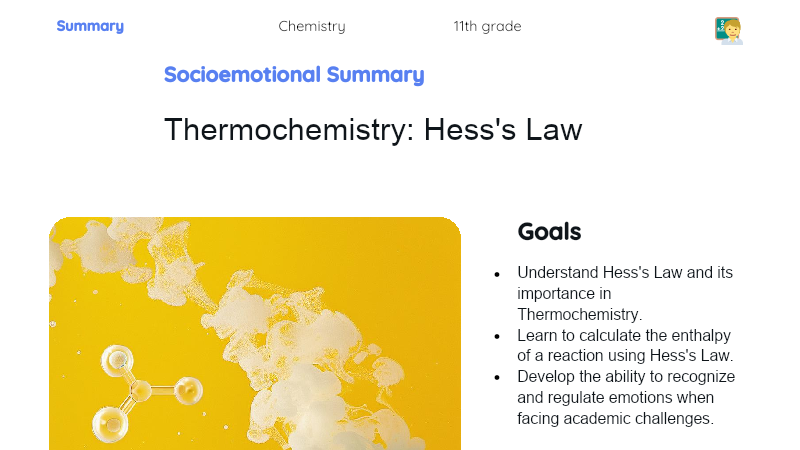Geometric Isomerism: Unveiling the Spatiality of Molecules
Introduction
- Relevance of the Theme: Geometric isomerism is a fundamental topic in understanding Organic Chemistry. It allows us to understand how different spatial arrangements of molecules give rise to substances with distinct properties even when sharing the same flat structural formula.
- Contextualization: Geometric isomerism is one of the types of structural isomerism, alongside chain and functional isomerism. It is found in various organic compounds, from hydrocarbons to compounds that contain heteroatoms. Its understanding is essential to explain various chemical and biological phenomena and is directly related to stereoisomerism, another important topic in the curriculum.
Theoretical Development
Components
-
Chemical Composition: Organic compounds that exhibit geometric isomerism are transformed into cis and trans isomers due to the restriction of rotation around the carbon with planar geometry (sp^2 carbons). These isomers have the same flat structural formula but differ in the relative position between the groups attached to these carbons.
-
Definition and Identification: Geometric isomerism (or cis-trans) occurs when, due to the presence of two carbons bonded to different groups, it is not possible to obtain one isomer from the other by simple rotation around a single carbon-carbon bond.
-
Concept of Cis-Trans Isomers: Cis-trans isomers are a subtype of geometric isomerism. In the cis isomer, identical atoms or groups are on the same side of the chain, while in the trans isomer, they are on opposite sides. This results in differences in the physical and chemical properties of the isomers, such as boiling point, melting point, solubility, and reactivity.
Key Terms
-
Geometric Isomerism: It is the phenomenon where compounds have the same chemical formula but differ in the spatial arrangement of atoms. Also known as cis-trans isomerism.
-
Planar Geometry: Characteristic of carbon atoms in double bonds, where the angle between two ligands is 120°.
-
Cis and Trans Isomers: These are geometric isomers that result from the impossibility of rotation of two units bonded to the same carbon atom.
Examples and Cases
-
Fumaric Acid and Maleic Acid: These are geometric isomers that have the same chemical formula C4H4O4. Fumaric acid is solid at room temperature and has a melting point of 286°C, while maleic acid is liquid and has a melting point of 130°C. This reflects the differences in intermolecular forces present in each compound due to its geometry.
-
2-Butene: It is a hydrocarbon that can exhibit geometric isomerism. In the case of 2-butene, there are two isomers, cis-2-butene and trans-2-butene. Cis-2-butene has a boiling point of -4.5°C, while trans-2-butene has a boiling point of -6.3°C.
Detailed Summary
Key Points:
-
Identification of Geometric Isomerism: It is essential to understand that geometric isomerism manifests through the impossibility of free rotation around double bonds or rings, causing different spatial arrangements of atoms. This leads to the formation of isomers with distinct physical and chemical properties, despite sharing the same flat structural formula.
-
Nature of Rotation Restriction: The restriction occurs around the carbon that has four different substituents (chiral carbon) or the carbon with planar geometry (sp^2 carbon). In these cases, rotation is impossible or limited, resulting in geometric isomers.
-
Cis and Trans Isomers: These are the main examples of geometric isomers. In the cis isomer, the substituents are on the same side, while in the trans isomer, they are on opposite sides. The properties and chemical behaviors can vary considerably between these isomers, giving rise to different substances.
Conclusions:
-
Geometric Isomerism as a Determinant of Properties: Geometric isomerism plays a crucial role in determining the physical and chemical properties of compounds. This is especially evident in considering cis and trans isomers, where small changes in spatial configuration can result in significant differences in properties.
-
Importance of Spatial Visualization: Understanding geometric isomerism requires the ability to visualize the spatiality of molecules. This skill can be developed through practice and the study of examples and cases.
Exercises:
-
Identify the Isomers: Given the compound C3H6Cl2, identify the possible geometric isomers, if any. Draw the structures of each isomer.
-
Prediction of Conduct: Consider the cis and trans isomers of 2-butene. Based on your knowledge of geometric isomerism, predict which isomer will have a higher boiling point and explain why.
-
Analysis of Properties: Compare the physical properties (boiling point, solubility) of fumaric and maleic acids. Explain how geometric isomerism contributes to these differences.



